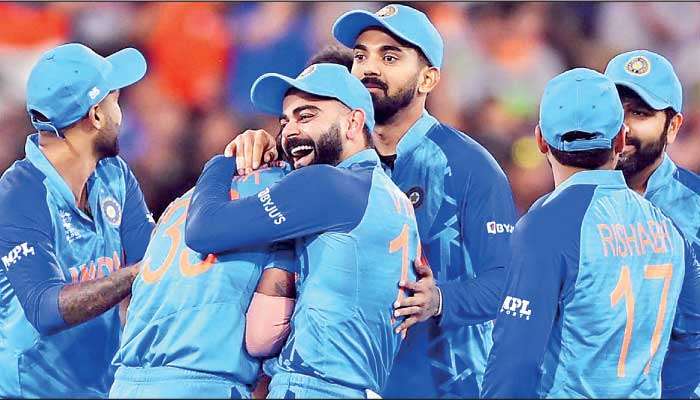There are many systemic mechanisms in place to nurture, develop and deploy its best
talents for the team’s benefit
- How it has created unprecedented value. And how Sri Lanka cricket must explore ways to have a mutually beneficial arrangement with BCCI to rejuvenate itself
 The USA men’s cricket team is in the final 8 of the T20 World Cup of cricket 2024. And beat Pakistan and Canada to get there. Who would have thought this possible just a few years back when cricket was a sport enjoyed by folk from the ‘ commonwealth nations’ and England, Australia and India besides people in Pakistan, Bangladesh and Sri Lanka were the ones primarily interested in the sport. But with big South asian diasporas in the US, the demand for the tickets in the USA have been huge and the marketing juggernaut is involving big names from other popular sports in the USA to popularize cricket there among the locals too. We could be seeing the first steps to cricket becoming a truly global sport.
The USA men’s cricket team is in the final 8 of the T20 World Cup of cricket 2024. And beat Pakistan and Canada to get there. Who would have thought this possible just a few years back when cricket was a sport enjoyed by folk from the ‘ commonwealth nations’ and England, Australia and India besides people in Pakistan, Bangladesh and Sri Lanka were the ones primarily interested in the sport. But with big South asian diasporas in the US, the demand for the tickets in the USA have been huge and the marketing juggernaut is involving big names from other popular sports in the USA to popularize cricket there among the locals too. We could be seeing the first steps to cricket becoming a truly global sport.
But the real story which has now enabled the fueling of global cricket is the story of the growth of Indian cricket. Enough has been written about the growth of the Indian economy, and enough is being written about the sheer dominance of BCCI (Board of Control for Cricket in India) in global cricketing affairs but this article is attempting to contextualise this rise for perspective and attempts to see if and how Sri Lanka cricket (which is facing significant challenges) can benefit from the rise of India in cr
In sheer wealth ( value) creation terms the story of Indian cricket has been incredible. In 2014/15, The net worth of the BCCI was around 500 million USD. And in the last ten years, this net worth has quadrupled to 2.25 billion USD in 2023*. For global context- the next highest cricket board in terms of net worth is the Australian cricket board with a net worth of 79 million USD. The Indian cricket board is 28 times richer than the next cricket board. All the world’s cricket boards net worth combined is only 16% of BCCI.*
One of the key contributors to this exponential rise of cricket India has been the humongous success of the Indian Premier League (IPL). A few months ago a leading global consultancy revealed the brand value of IPL to be at $ 10.7 billion. This represents a 433% increase in value ever since its launch in 2008. And a 28% increase over the previous year.*
IPL recently sold its broadcasting rights for the period 2023-27 for $6.2 billion. This makes it an incredible $16.8 million being paid per match*. Only the NFL (National Football League in the USA) pays more per match for broadcasting rights. IPL has well and truly arrived as one of the richest global sporting leagues.*
Recently during the ongoing T20 World Cup in the USA, some American commentators were stunned to know that Virat Kohli from India had 381 million followers on social media making him one of the world’s top 3 sportsmen (in terms of social media followers) after only Cristiano Ronaldo and Lionel Messi. Kohli has more followers than big sporting icons such as Neymar or LeBron James or Kylian Mbappe. This indicates the influence and impact of Virat Kohli on the global audience in sport.*
Indian cricket itself has benefited tremendously from this rise. Indian cricketers are some of the best paid. And earn big bucks for their appeal to their fan following through endorsements for brands. Also from a team perspective IPL has helped unearth a plethora of cricket talent in India. There are many systemic mechanisms in place to nurture, develop and deploy its best talents for the team’s benefit. And it’s showing results in the Indian team. Indian fast bowling and fielding, often considered its weak points have seen tremendous improvement and the Indian team today boasts of one of the best fast bowling attacks in the world as well as a bunch of fit energetic cricketers throwing themselves at the ball.
While the Indian team is yet to fully realise its potential on the field- it’s clear to all lovers of the sport that India is a formidable force not only in the ICC board rooms but also on the field playing the sport.
Tremendous value is being created in Indian cricket- for the players, for the stakeholders such as broadcasters, franchise owners as well as the cricket loving public at large. Indian cricket seems to be in fine fettle. And by and large all seems to be well with Indian cricket going forward.
Contrary to beliefs the rise of IPL has not been at the cost of test cricket. In fact T20 cricket has revitalised test cricket and India has been in the world test championship final twice.
This ecosystem fueled by IPL has meant the Indian team has performed consistently in all three formats of the game – Test cricket, ODI and T20s.
On the other hand it’s fair to say that Sri Lanka Cricket is going through a turbulent time. The team has not quite come together to perform and deliver results causing serious anguish among the people of the country. It would not be an exaggeration to say that in South Asia the country’s mood and self-esteem depends a lot on the performance of its cricket team. And Sri Lankan cricket has not contributed recently to keeping everyone in a fine fettle.
And while India and Sri Lanka are seeking to create closer bonds and ties across many areas of mutual economic interest, and the cultural and historical bonds have always been deep and strong, let’s explore how India’s cricketing rise can benefit Sri Lanka cricket.
From an individual player perspective clearly IPL has created opportunities for Sri Lankan cricketers and they themselves are seeing symbiotic value in it. For instance a player like Lasith Malinga has been at the forefront of the success on the field for Mumbai Indians.(MI) His bowling especially at the death has won many a crucial game for MI. And he has been an inspiration for India’s own fast bowling star Jasprit Bumrah. Similarly iconic Sri Lankan cricketers such as Mahela Jayawardene and Kumar Sangakkara are making invaluable contributions in strategic roles at MI and Rajasthan Royals. And by all accounts, they are finding the space and opportunity to express their skills in these teams. And for the value they create there is no doubt commensurate financial benefits.
Individuals such as Wanindu Hasaranga (current Sri Lanka captain), Maheesh Theekshana, Matheesha Pathirana and NuwanThushara have all played invaluable roles in their IPL franchisees success and they in turn have been rewarded with fame loyalty and love from their franchisee fan base. And there are significant financial benefits as a result.
But despite this talent existing, and a few being unearthed by IPL, Sri Lanka cricket have not been able to create significant impact on the field as a national team, in the recent past.
Part two of this article tomorrow will explore possible ways a closer integration of ambitions of Sri Lanka and BCCI can combine to create symbiotic value for both and thereby get Sri Lanka cricket back to its glory days. Is there a way Sri Lanka cricket can ride on the back of a BCCI model of success without compromising on the Sri Lankan brand or ethos of cricket.
Can Sri Lanka Cricket negotiate with BCCI such a deal that benefits and creates long term stability for itself while providing value for the IPL, Corporate interests, broadcasters and fans in India. Is there a win-win formula that both parties can adopt and benefit from?
We will continue our exploration in Part -2 tomorrow
*all data from legitimate sources on the internet
(The author is an Indian businessman based in Sri Lanka and contributes regularly on topics of common interest to India and Sri Lanka. He can be reached at [email protected])

